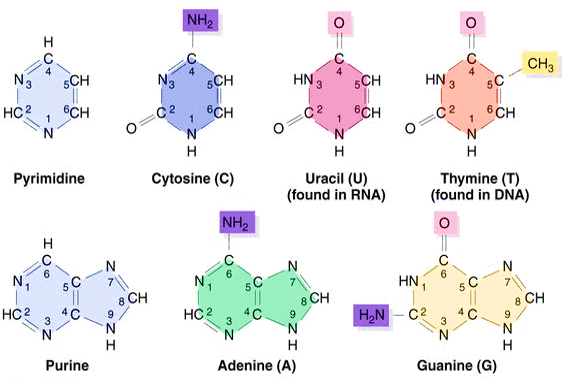Danna Esther Gelfand
Jed Quiaoit
AP Biology 🧬
358 resourcesSee Units
Nucleic acids are large complex molecules that play a crucial role in the storage, transmission, and expression of hereditary information. They are made up of monomers called nucleotides, which consist of a 5-carbon sugar, a nitrogenous base, and a phosphate group. There are two main types of nucleic acids: deoxyribonucleic acid (DNA) and ribonucleic acid (RNA). DNA is the genetic material that stores the instructions for building proteins, while RNA is involved in the synthesis of proteins from the instructions stored in DNA. 🍭
Genes are a specific unit of inheritance that contain the instructions for synthesizing particular proteins. They are made of DNA and are found on chromosomes. The sequence of nucleotides in a gene determines the sequence of amino acids in a particular protein, which in turn determines the protein's function. 🔧
Deoxyribonucleic Acid
Deoxyribonucleic acid (DNA) is a molecule that stores and transmits genetic information. It is responsible for directing its own replication, causing the synthesis of messenger RNA (mRNA), and using mRNA to control protein synthesis. The sugar in DNA is deoxyribose.
Nucleic acids have a linear sequence of nucleotides that are linked by covalent bonds. The sequence is defined by the presence of a hydroxyl group (-OH) on the 3' carbon of one nucleotide and a phosphate group on the 5' carbon of the next nucleotide. During DNA and RNA synthesis, nucleotides are added to the 3' end of the growing strand, forming covalent bonds between adjacent nucleotides. This process is essential for the replication and expression of genetic information. 🧠

Image courtesy of Wikimedia Commons.
Purines and Pyrimidines
The nitrogenous bases in nucleic acids are important because they are the key players in the genetic code. There are five nitrogenous bases in total: cytosine (C), thymine (T), uracil (U), adenine (A), and guanine (G).
Uracil is only found in RNA, while thymine is only found in DNA. The nitrogenous bases can be divided into two categories: purines and pyrimidines.
- Purines, which include adenine (A) and guanine (G), have a double-ring structure.
- Pyrimidines, which include thymine (T), cytosine (C), and uracil (U), have a single-ring structure.
Each purine pairs with a pyrimidine, bonded together with hydrogen-bonding. This base-pairing allows for the stability and accuracy of DNA replication and the transmission of genetic information from one generation to the next.

Image courtesy of EpoMedicine
Chargaff’s Rule
Base pairing rules of purines and pyrimidines
- Adenine pairs with thymine (A-T); two hydrogen bonds when pairing the bases.
- Guanine pairs with Cytosine (G-C); three hydrogen bonds when pairing the bases.
DNA is arranged in a double helix made of two strands of nucleotides held together by hydrogen bonds. Each strand of DNA consists of a sugar-phosphate backbone that keeps the nucleotides connected with the strand. RNA (ribonucleic acid) tends to be single-stranded, yet also has a sugar-phosphate backbone. The three types of RNA you should know: mRNA (messenger RNA), tRNA (transfer RNA), and rRNA (ribosomal RNA).
A prime (ʹ) identifies the carbon atoms in the ribose, such as the 2ʹ carbon or 5ʹ carbon. DNA is structured as an antiparallel double helix, with each strand running in opposite 5’ to 3’ orientation, and the 5’ end of one molecule is paired with the 3’ end of the other molecule and vice versa.
Example (with Arithmetic)
A researcher isolates a sample of DNA from a species of plant and finds that it contains the following amounts of the four nitrogenous bases: adenine (A) = 40%, thymine (T) = 40%, and cytosine (C) = 10%.
According to Chargaff's rule, what is the percentage of guanine in the sample?
To solve this problem, we can use Chargaff's rule, which states that in a double-stranded DNA molecule, the percentage of A is equal to the percentage of T, and the percentage of G is equal to the percentage of C.
Since the percentage of A in the sample is 40% and the percentage of T is 20%, we know that the percentage of G must be equal to the percentage of C, which is 10%. Therefore, the percentage of guanine in the sample is 10%!
DNA vs. RNA
While it's highly unlikely for an AP Biology standalone MCQ or FRQ to ask about the similarities and differences between DNA and RNA, it's important to learn the foundational knowledge to answer more complex, application-centered questions down the road!
⭐ Key similarities between the two:
- Both are nucleic acids, meaning they are made up of nucleotides.
- Nucleotides in both DNA and RNA consist of a sugar molecule, a phosphate group, and a nitrogenous base.
- Both contain the nitrogenous bases adenine, guanine, and cytosine.
- Both are involved in the transmission of genetic information.
- Both play important roles in the synthesis and regulation of proteins.
⭐ Key differences between the two:
- The sugar molecule that they contain. DNA contains deoxyribose, which is a sugar molecule with one less oxygen atom compared to ribose, the sugar molecule found in RNA. Another difference is the presence of different nitrogenous bases.
- Nitrogenous bases. DNA contains the bases adenine, guanine, cytosine, and thymine, while RNA contains the bases adenine, guanine, cytosine, and uracil.
- Structure. DNA is usually double-stranded, meaning it has two complementary strands that are held together by hydrogen bonds. RNA, on the other hand, is usually single-stranded, although some RNA molecules may be partially or fully double-stranded.
- Orientation and directionality for DNA. Uniquely In double-stranded DNA, the two strands are oriented in opposite directions, with one strand running 5' to 3' and the other running 3' to 5'. This is known as antiparallel orientation.
These structural differences between DNA and RNA are important because they contribute to the unique functions of these two types of nucleic acids. DNA is responsible for storing genetic information and transmitting it to future generations, while RNA plays a variety of roles in the synthesis and regulation of proteins, as well as other cellular processes.
Browse Study Guides By Unit
🧪Unit 1 – Chemistry of Life
🧬Unit 2 – Cell Structure & Function
🔋Unit 3 – Cellular Energetics
🦠Unit 4 – Cell Communication & Cell Cycle
👪Unit 5 – Heredity
👻Unit 6 – Gene Expression & Regulation
🦍Unit 7 – Natural Selection
🌲Unit 8 – Ecology
📚Study Tools
🧐Exam Skills

Fiveable
Resources
© 2025 Fiveable Inc. All rights reserved.